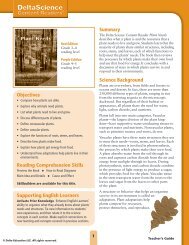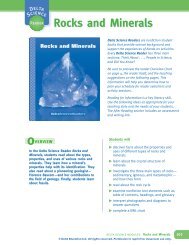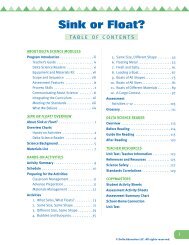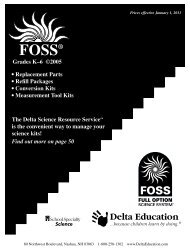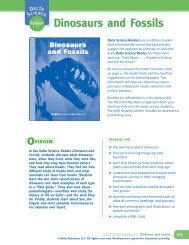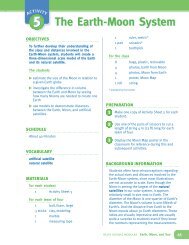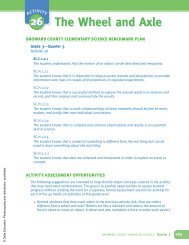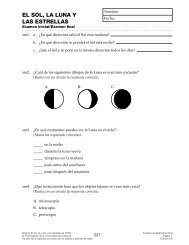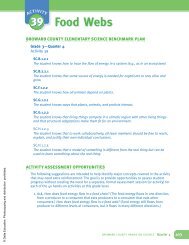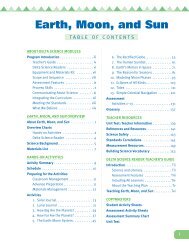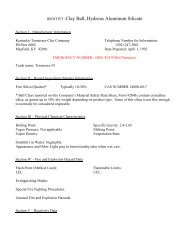Newton's Toy Box Overview - Delta Education
Newton's Toy Box Overview - Delta Education
Newton's Toy Box Overview - Delta Education
Create successful ePaper yourself
Turn your PDF publications into a flip-book with our unique Google optimized e-Paper software.
About Newton’s <strong>Toy</strong> <strong>Box</strong><strong>Delta</strong>ScienceModules, THIRD EDITIONStudents experiment freely with familiar toys andobjects. As they explain their observations, they proveNewton’s three laws of motion. The path of a tossed ball,the flip of a grasshopper toy, and the endless swing ofclackers reinforce the concepts of inertia, gravity,acceleration, mass, force, and momentum. Studentsengage in races, games, and challenges that emphasizethe laws of motion, which govern everyday tasks andcosmic interactions. The kit includes a video so studentscan compare the behavior of the toys on Earth with theirbehavior in a microgravity environment. By dealing withscaled-down applications, middle school students graspthese laws and master the vocabulary of physics.In the <strong>Delta</strong> Science Reader Newton’s <strong>Toy</strong> <strong>Box</strong>, studentsdelve into the basic physics of motion. They find outhow motion is described in terms of distance, direction,motion, speed, velocity, and acceleration. They discoverthe effects of friction and gravity on objects and read aboutconservation of momentum. Newton’s laws of motion areexplained and illustrated so that students can comprehendhow and why objects move, or don’t. Students alsoinvestigate the relationship among force, energy, power,and work and then explore the devices that make workeasier. They learn how the six simple machines provide amechanical advantage, such as multiplying input force, andhow the efficiency of simple and compound machines iscalculated. In a biographical sketch, they are introduced toSir Isaac Newton. They also read about satellite motion—how satellites are placed in orbit and how they stay there.Newton’s <strong>Toy</strong> <strong>Box</strong> 1
<strong>Overview</strong> Chart for Hands-on Activities1Hands-on ActivityMotion in Reviewpage 132 Gravity and Balancepage 193Moving Massespage 254 The Parachute Droppage 335Basketball Arcspage 396 Ball and Cup Contestpage 457Rolling Onpage 498 Great Racepage 55Student Objectives• observe that an object at rest remains at rest until a force acts on it• describe the motion of an object when it experiences a force• identify gravity as the force that makes an object fall• measure the strength of the gravity force on an object• compare gravity and gravity support forces• describe the relationship between mass and weight• observe the relationship between force and acceleration• observe the relationship between force and mass• predict the falling rate of balls of different masses• observe the effects of air resistance on falling objects• use air resistance to slow the speed of a falling object• compare the parachute requirements for objects of different masses• observe the trajectory of a thrown ball• apply what they observe to the game of basketball• predict how the ball would behave in a microgravity environment• observe the path of a circling ball• describe how gravity is used to catch the ball• predict how the toy can be operated in a microgravity environment• measure the distance traveled and the elapsed time for a moving object• calculate the speed of a moving object• observe how the speed of a moving object changes on different surfaces• calculate the average speed of a car rolling down a ramp• compare the speed of a car to its starting height on the ramp• relate gravitational potential energy to kinetic energy9Accelerating Massespage 61• observe the acceleration of a car rolling down a ramp• calculate the average speed of the car at two different points on the ramp• determine whether the car is accelerating10 The Come-Back Canpage 67• construct a come-back can• predict what will happen to the can when it is rolled forward• demonstrate how energy is conserved in a come-back can111213Action-Reactionin Action page 73The GrasshopperGame page 79Clacker Conservationpage 85• identify the action and reaction forces when a ball bounces• predict the behavior of a spring jumper on the basis of action-reaction forces• describe the action and reaction forces involved in a flipping paper grasshopper• compare the jumping ability of paper grasshoppers of different masses• observe and identify action and reaction forces that cause the clacker to behaveas it does• identify momentum conservation behaviors in clackers that demonstrate thatmomentum is conserved• predict which clacker behaviors will be possible in microgravityAssessment page 91 • See page 91.2 delta science modules
Process SkillsVocabularyNewton’s <strong>Toy</strong> <strong>Box</strong><strong>Delta</strong> ScienceReaderobserve, investigate, communicate force, inertia, Newton’s first law of motion, velocity pages 2–3, 4,10–11, 22observe, measure, compare,record data, use numbersgravity, gravity support force, newton (N), pound (lb),weightpages 4–5, 8communicate, measure, recorddata, conclude, observe, predictacceleration, mass, Newton’s second law of motion pages 4–5, 8,12, 22observe, hypothesize, experiment,use variables, predict, compareair resistance pages 6–8observe, experiment, predict free fall, parabola page 23collect data, experiment, conclude,predictmicrogravity page 23measure, collect and record data,use numbers, interpret data,conclude, define based onobservationsmeasure, collect and record data,use variables, use numbers,interpret data, communicate,comparemeasure, observe, collect andrecord data, use numbers,interpret data, concludedistance, friction, speed, time pages 3, 6–7energy, gravitational potential energy, kinetic energy,potential energypages 3, 14pages 4–5investigate, observe, communicate,infer, predictconservation of energy, elastic potential energy page 14observe, experiment, use variables,collect and record data, predict,define based on observationsobserve, predict, communicate,compareaction force, Newton’s third law of motion, reaction force pages 13, 22page 13observe, analyze data, predict conservation of momentum, momentum page 9See the following page for the <strong>Delta</strong>Science Reader <strong>Overview</strong> Chart.Newton’s <strong>Toy</strong> <strong>Box</strong> 3
<strong>Overview</strong> Chart for <strong>Delta</strong> Science ReaderNewton’s <strong>Toy</strong> <strong>Box</strong>SelectionsThink About...Motion and Speedpages 2–3• Changing Position• Speed and VelocityForces and Motionpages 4–9• What Are Forces?• How Do Forces Affect Objects?• What Is Friction?• What Is Gravity?• What Is Momentum?Newton’s Laws of Motionpages 10–13• Newton’s First Law• Newton’s Second Law• Newton’s Third LawWork, Energy, and Powerpage 14Vocabularyaverage speed, displacement, distance,motion, position, reference point, speed,velocityacceleration, air resistance, balancedforces, force, friction, gravity, law ofconservation of momentum, mass,momentum, net force, newton, terminalvelocity, unbalanced forces, weightinertia, Newton’s first law of motion,Newton’s second law of motion, Newton’sthird law of motionenergy, joule, kinetic energy, potentialenergy, power, workRelatedActivityActivity 1Activities 2, 3,7, 8, 9, 13Activities 1, 3,11, 12Activities 8, 10Machines and Workpages 15–21• Mechanical Advantage• Efficiency• Simple Machines• Compound Machinescompound machine, efficiency, fulcrum, gear,inclined plane, input force, lever, machine,mechanical advantage, output force, pulley,screw, simple machine, wedge, wheel andaxle, work input, work outputPeople in Science• Sir Isaac Newtonpage 22Did You Know?• About Satellite Motionpage 23law of universal gravitationfree fall, satelliteActivities 1, 2,3, 11Activities 4, 5,6, 10, 134 delta science modulesTeaching suggestions for the <strong>Delta</strong> ScienceReader are in a 32-page booklet includedwith this guide.
MATERIALS LISTQuantity Description Quantity DescriptionNewton’s <strong>Toy</strong> <strong>Box</strong>8 . . . . . . . . . bags, mesh, for spring scale1 . . . . . . . . . balance ball set8 . . . . . . . . . balls and hoops8 . . . . . . . . . balls, steel17 . . . . . . . . . balls, table tennis16 . . . . . . . . . balls, wooden8 . . . . . . . . . cars16 . . . . . . . . . clackers1 . . . . . . . . . Come-Back Can Instructions12 . . . . . . . . . connectors17 . . . . . . . . . cups, paper, 3-oz1 . . . . . . . . . <strong>Delta</strong> Science Dictionary1 . . . . . . . . . <strong>Delta</strong> Science DictionaryCopymaster Booklet1 . . . . . . . . . Grasshopper Instructions1 . . . . . . . . . Grasshopper Patterns10 . . . . . . . . . hex nuts10 . . . . . . . . . jars, plastic, with hole10 . . . . . . . . . lids for jars, with hole1 . . . . . . . . . paper clips, p/100*16 . . . . . . . . . parachute sheets*1 . . . . . . . . . poster, Building ScienceVocabulary1 . . . . . . . . . poster, MeasurementResources1 . . . . . . . . . poster, Science Safety1 . . . . . . . . . rubber bands, p/608 . . . . . . . . . scales, spring16 . . . . . . . . . spring jumpers17 . . . . . . . . . sticks, wooden, flat8 . . . . . . . . . stopwatches1 . . . . . . . . . string, kite, 250-ft roll4 . . . . . . . . . tape, masking, rolls*8 . . . . . . . . . tapes, measuring16 . . . . . . . . . tracks1 . . . . . . . . . videotape, <strong>Toy</strong>s in SpaceTEACHER-PROVIDED ITEMS32. . . . . . . . . books, hardcover1. . . . . . . . . calculator (optional)1. . . . . . . . . chalk piece (optional)16. . . . . . . . . paper, white, sheets32. . . . . . . . . pennies16. . . . . . . . . rulers or meter sticks1. . . . . . . . . scale, bathroom (optional)32. . . . . . . . . scissors8. . . . . . . . . towels, friction1. . . . . . . . . VCR and monitor1 . . . . . . . . . Teacher’s Guide8 . . . . . . . . . <strong>Delta</strong> Science Readers* = consumable item † = in separate boxTo order consumable items or refill kits, please call 1-800-442-5444.Newton’s <strong>Toy</strong> <strong>Box</strong> 7
ACTIVITY SUMMARYIn this <strong>Delta</strong> Science Module, students areintroduced to many fundamental concepts inphysics as they experiment freely with familiartoys and objects and then are asked to definewhat they observe in terms of Newton’s threelaws of motion.ACTIVITIES 1, 2, and 3 Students review gravity,motion, and the relationship between mass andforce. They observe simple behaviors and thendefine them using the terms motion, force,mass, velocity, inertia, gravity, andacceleration.ACTIVITY 4 Students continue to explore thelaws of motion. They investigate the variablesthat affect air resistance when they construct aparachute and use it to slow the speed of fallingobjects.ACTIVITY 5 Students examine the parabolicpath of a tossed ball. While playing the familiargame of basketball, students recognize justhow they manipulate the angle of the arc inorder to correctly position where the ball willfall.ACTIVITY 6 Students experiment with thetraditional “ball and cup” and then explain howgravity and Newton’s second law affect the toy.ACTIVITY 7 Students reexamine Newton’s firstlaw when they observe, and then define, theforce that opposes the forward motion of amoving object—friction. Students calculate thespeed of a toy car in three different situationsand then identify the degree of friction as thevariable that accounts for the differences inspeed.ACTIVITY 8 Students accelerate their toy carsby elevating the track to form a ramp. As thecars descend the ramp, their gravitationalpotential energy (due to position) is convertedto kinetic energy (in the form of motion).Students vary the elevation of the ramp andthen measure the resultant speeds of thedescending cars using stopwatches.ACTIVITY 9 Students measure the actualacceleration of their cars as they descend theramp.ACTIVITY 10 Students explore Newton’s thirdlaw of motion—action and reaction—with acome-back can, a simple device that stores andthen releases energy. Students construct thecans, observe their behavior, and then describeit in terms of potential and kinetic energy.ACTIVITIES 11 and 12 Students continue toexamine action and reaction by way of springjumpers and student-assembled paper modelsof grasshoppers.ACTIVITY 13 Students demonstrateconservation of momentum, another wayof looking at Newton’s third law, using freehangingobjects. They experiment withanother popular toy, the clacker, and describeits behavior in terms of momentum andtransfer of energy.In conjunction with the activities they perform,students watch a video in which astronautsexperiment with some of the same toys thatstudents are experimenting with. Studentscompare the behavior of the toys on Earth withthe behavior of the toys in a microgravityenvironment and see that many of thetechniques they use to operate their toys hereon Earth depend on Earth’s gravitational force.Newton’s <strong>Toy</strong> <strong>Box</strong>9



